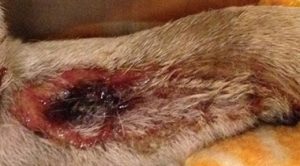AMERICAN XL BULLY DOG BAN: WHAT DOES THIS MEAN FOR OWNERS?
On 15 September the Prime Minister announced plans to ban American XL Bully dogs in the UK. We understand that this Government announcement is hugely concerning and upsetting for many, and we will support American XL Bullies and their owners as best we can over the coming months.
From 31 December 2023 it will be against the law to:
- sell an XL Bully
- abandon an XL Bully
- give away an XL Bully
- breed from an XL Bully
- have an XL Bully in public without a lead and muzzle
From 1 February 2024 it will be a criminal offence to own an XL Bully in England and Wales unless you have a Certificate of Exemption for your dog.
HOW DO I KNOW IF I HAVE AN XL BULLY DOG?
The Government have released an official definition of an XL Bully dog to identify if your dog may be an XL Bully. This involves checking the dog’s physical characteristics such as its size and height.
Height is a necessary requirement so you should assess your dog’s height first, measuring from the ground to the withers (the top of the shoulders) and not higher. The minimum height is:
- 20in (51 cm) at the withers for an adult male.
- 19in (48cm) at the withers for an adult female.
If the minimum height is not met, then your dog is not considered an XL Bully and no further assessment is needed. If your dog meets the height requirement, you will need to work through the rest of the definition.
Read Official DefinitionKEEPING AN XL BULLY DOG
From 1 February 2024 it will be a criminal offence to own an XL Bully in England and Wales unless you have a Certificate of Exemption for your dog. You have until 31 January 2024 to apply for this exemption.
To keep an XL Bully dog you must ensure it is:
- microchipped.
- kept on a lead and muzzled at all times when in public.
- kept in a secure place so it cannot escape.
You will also need to neuter your dog. If your dog is less than one year old on 31 January 2024, it must be neutered by 31 December 2024. If your dog is older than one year old on 31 January 2024, it must be neutered by 30 June 2024. We recommend that you arrange for your dog to be neutered as soon as possible to ensure that you meet these deadlines.
As the owner, you must also:
- be over 16 years old.
- take out insurance against your dog injuring other people.
- be able to show the Certificate of Exemption when asked by a police officer or a council dog warden, either at the time or within 5 days.
If you own an American Bully XL type dog, we recommend you start preparing now, by making sure your dog is neutered, microchipped, and trained to wear a muzzle.
HOW DO I APPLY FOR A CERTIFICATE OF EXEMPTION?
You can apply via the Government’s website, through their online portal or by downloading the form to apply by post. The deadline for online applications is 12 noon on 31 January 2024. If applying by post, your application must arrive before 15 January 2024.
Through the online form you can apply for up to three dogs in one go. If you have more than three dogs, you will need to repeat the process to apply for the remaining dogs. By post you can apply for up to 30 dogs at a time. For example, if you have five dogs, you can apply for three in one go, then apply again for the remaining two.
Before you apply for a Certificate of Exemption you must:
- Pay the £92.40 application fee for each dog you want to apply for – you’ll need your 10-digit payment reference number.
- Have third party public liability insurance for banned breeds of dogs – you’ll need to know the start date of your insurance.
- Have your dog microchipped – you’ll need to provide their microchip number. To find their microchip number, check the dog’s vaccination record or ask us. (If your dog is less than 8 weeks old when you apply for a Certificate of Exemption, you’ll have until 31 March 2024 to give the microchip number.)
You’ll also need to provide evidence your dog has been neutered. For your Certificate of Exemption to remain valid, you and your vet must complete a VCN01 form and return to Defra by the dates below. You can download the form from the Government’s website.
- If your dog is less than 1 year old on 31 January 2024, they must be neutered and the VCN01 form received by Defra by 31 December 2024.
- If your dog is more than 1 year old on 31 January 2024, they must be neutered and the VCN01 form received by Defra by 30 June 2024.

 [checklist icon=”fa-paw” iconcolor=”#39aa87″ circle=”yes”]
[checklist icon=”fa-paw” iconcolor=”#39aa87″ circle=”yes”]



